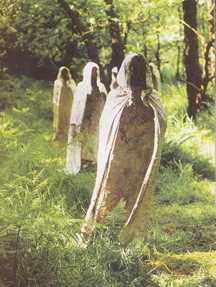The Bottomley Witch Project
At last darkness had fallen and we could begin our quest. It was not safe to visit Robin Hood’s Grave in daylight hours – gamekeepers prowled the woods of Kirklees, shotguns at the ready for the apprehension of those who sought to visit the famous – or was it infamous – last resting place of England’s greatest and most beloved hero. My three visitors from Nottingham, Vi, Jan and her husband Clive, were raring to go, so taking a last look at the deepening sky and deciding that, by the time we arrived at Wakefield Road, it would be sufficiently black, we made a final check of our equipment – torches, cameras and Vi’s crystal – of which more later – and piled into Clive’s landrover and roared off down the road. Ten minutes later we were parked at the side of Robin Hood cottage, on a little side road off Wakefield Road. Directly opposite, on the other side of the busy road, was the crumbling, six foot high wall which we could have to leap over- (hopefully!) – to start our trek up the wooded hillside leading to the grave. My last unofficial trip to Robin’s grave had been around four years previously and I was a little worried about finding it again, especially in the dark. The grave is well hidden beneath an almost impenetrable jungle of dense undergrowth and rhododendron bushes, which mysteriously seem to change shape every time I go looking for it! Unfortunately Jan, who is slightly disabled, found she was unable to climb over the wall, so she and Clive stayed behind in the getaway vehicle while Vi and I went on alone. Scrambling, rather than leaping (for passing cars were a non stop stream and we were forced to be seen, hence the haste) we plunged into a treacherous morass of deep fern, brambles and stinging nettles. The first stage of our quest was to ascend the steep wooded hillside leading to the overgrown King’s Highway, the medieval road from London to York. This was simple enough despite the rampant foliage and in my mind I knew the way towards Robin’s grave once we reached this point. Turn right through the rhododendron tunnel. There was another way, if you turned left, but this involved climbing a sheer rockface which I had christened the North Face of the Eiger, but I had only taken that route once and was more familiar with the alternate way. So much for the theory! Once in the bushes I became hopelessly lost, though I recognised the ancient tree standing in a clearing in the middle of the undergrowth. It stood like a guardian witch to the labyrinth, primeval and terrifying , it’s grotesque branches reaching out, as though casting some hideous spell upon us. Whatever the cause, I missed the vital exit and Vi and I were soon swallowed up by gigantic ferns and creeping, strangling brambles and stumbling and struggling through a murderous green wilderness. Fierce thorns stabbed and scratched us like living creatures, monstrous stinging nettles attacked our faces and hands and great holes lay in wait for us to fall into………. “Help!” cried Vi, as once more she crashed into a crevasse, with me following on top of her. I knew I was going round in a circle when I reached another stone wall which I yanked poor Vi over – it was at least eight foot high – and we found ourselves almost eye to eye with a herd of young bulls. That was the final straw! We abandoned our search until the morrow, when we would have to risk the gamekeepers and their blunderbusses. Vi consulted her crystal and its vibrations advised us that we were nowhere near Robin’s grave, which was certainly a very accurate assessment of the situation. Battered, bruised and very disappointed, we retreated back to Jan and Clive, who reported seeing hooded figures, (psychically) watching our doomed expedition in thrashing about in the woods. The following day found VI and me retracing our footsteps up the hillside and this time we found the grave within ten minutes. We even stumbled upon the mysterious “tower”, a Victorian shooting lodge built on the site of a Roman fort and now completely buried in the glorious purple and red rhododendron bushes. Robin’s grave was in the same deplorable state as I last remembered it, all green, mouldering, tumbled stones and rusted, twisted railings. The same ominous atmosphere of complete silence, the curious absence of birdsong, made my hair stand on end. Nothing had changed. “Something” was still there. Vi and I held hands as we leaned over the walls and tried to link in with the hovering forces. My psychically gifted companion had no difficulty in contacting Robin’s presence but all I could feel was the cold, dark oppression, the abomination of desolation. When, I wondered, would Robin’s grave receive it’s blessing and be freed from the evil which surrounded it? When would we see Robin rightly honoured for the place he held in English history? And why did so famous and universally loved a hero continue to be totally neglected in death? We completed our Robin Hood tour by visiting the Norman church at Hartshead. This place has several connections with the legend. It is a pre-Reformation church built on a pagan site around a wondrously ancient yew tree, from which Robin may have cut his bows. It is part of the ley line stretching through Kirklees and Robin’s gravesite to Castle Hill (the Yorkshire Glastonbury) at Almondbury. The ley connection is important, for another of these mystical lines crosses Robin’s grave, thus making it a focus for the harnessing of occult powers. Vi was entranced by the yew tree. It is undeniably a most beautiful sight in it’s majestic, ruined antiquity, its silky smooth grey bark twirling and swirling into intricate patterns and delicate, pastel shades, though it’s back is all black and charred where the fatal lightning bolts truck at it’s old heart and killed it in the nineteenth century. Near the Verger’s entrance is half a gravestone, showing a stepped cross, exactly like the one drawn of Robin’s original monument, before it disappeared during the English Civil War. A new find for me was the tombs of the Armytage servants, erected in a now neglected part of the churchyard. One read: “Samuel Turner, gamekeeper, a strictly faithful servant for forty years. 1829” I could not resist a little jig over the good lackey and his wife, Mary who was recorded as being “much respected for her fidelity and uprightness of conduct.” We ended our day at the Three Nuns Inn, built on the site of the ancient hostelry where three of the Kirklees nuns had taken refuge at the time of the Dissolution of the Monasteries. The pub is simply infested with ghosts, all somehow connected with the Knights Templar effigy, a carved ram’s head, hidden, we were told, at the back of the lounge fireplace, over which a very evocative picture of the three cloistered ladies is painted. Katherine Grice, the novice who committed suicide after being abandoned by the father of her child, one of the Good King Hal’s monastic inspectors and Dames Joan Leverthorpe and Cecilia Topcliffe. Perhaps too, the spirit of Dame Mary Startin, the prioress who bled Robin to death, glides among the phantom company of the Three Nuns Inn, reaching out with her cold hands to touch the unsuspecting bar staff, or moving things from their places, making them vanish…..This is no Blair Witch hoax. Robin Hood’s Grave and its haunted surroundings is for real. Robin Hood’s Grave 2000. Bottomley Witch Project PART TWO by John Pope de Locksley
In October 200 I arrived in Brighouse to research my family connections with Robin Hood. The Bottomleys are a Bradford born family who maintain a tradition that they are descended from Robin Hood, who, they believe, is buried in Hartshead Church, about one mile from Kirklees in West Yorkshire. My cousin Beryl described to me a stone with a five stepped cross on which the family placed flowers every year- exactly like the one drawn by Nathaniel Johnson in the 17th century. The Hartshead stone is situated beside the verger’s entrance to the church. My visit coincided with Barbara Green’s news that she had received an e-mail from a certain David Hepworth who said that he had been specially invited by Lady Armytage to do research at Kirklees and was being aided by Professors Knight, Holt and Dobson, (also a Professor Ohlgren) all Robin Hood authors. Barbara was somewhat astounded at this information as she had always been refused permission to conduct any research at Kirklees. However, as all the Kirklees documents had reportedly been handed over to Halifax Central Library some years previously and no archaeological dig was involved, this was not seen as particularly important, though admittedly it was annoying. Even more so was Mr Hepworth’s news that he was going to publish the prioress’ story, which Barbara had already done. Soon steam was coming out of the ears of Barbara’s computer as purple e-mails thundered down the line! I was accused of having recently escaped from a mental institution, while Barbara was called scandalous, alarmist and hysterical! Amid it all Professors Holt and Knight hastened to deny all knowledge of the business at all! At the present moment, November 2000, we are still trying to unravel this latest enigma surrounding Robin Hood’s famous – or is it now infamous – grave! Notwithstanding all this hoo ha a friend and I went up to Robin’s grave at midnight on All Hallows e’en. It was the time of the great October floods and pouring with rain, the leafless trees allowing the torrential rain to bucketdown upon us while we struggled through the dripping monster ferns of the Kirklees rainforest. Above, a hazy waning moon could be seen through the web of black branches. Despite the adverse weather conditions, I managed to light the candles on the crumbling wall of Robin’s grave and burned incense. As an ordained minister of a Christian order and a third degree witch, I blessed the grave. I put vervain oil on it and invoked Robin’s presence while placing a circle of protection around his grave. At that point I felt very strongly that we were being watched, as did my companion-though whether it was by gamekeepers or ghosts, we were not sure! We moved on to the real grave in Hartshead where I had a vision of Robin kneeling by his grave. It resembled the old Clifton mosaic which mysteriously disappeared during World War II-allegedly taken down for fear of parachuting Germans and now thought to be buried beneath the M62
|
||
|


